02 Body Art Research
The body¶
The body is a vessel for our souls that carries us through time and space. We function through the mechanical structure of our anatomy, survive from our logical thinking, but we thrive through the emotional connection of our mind and heart.A complex, highly organized structure made up of unique cells that work together to accomplish the specific functions necessary for sustaining life and one of the most beautiful and complex creations of nature.

Art¶
Art allows our minds to see a topic from a unique perspective. Art highlights what the artists feels needs to be shown and discussed. The body in motion is one of the strongest mediums to express such topics due to its prominent attention grabbing approach.
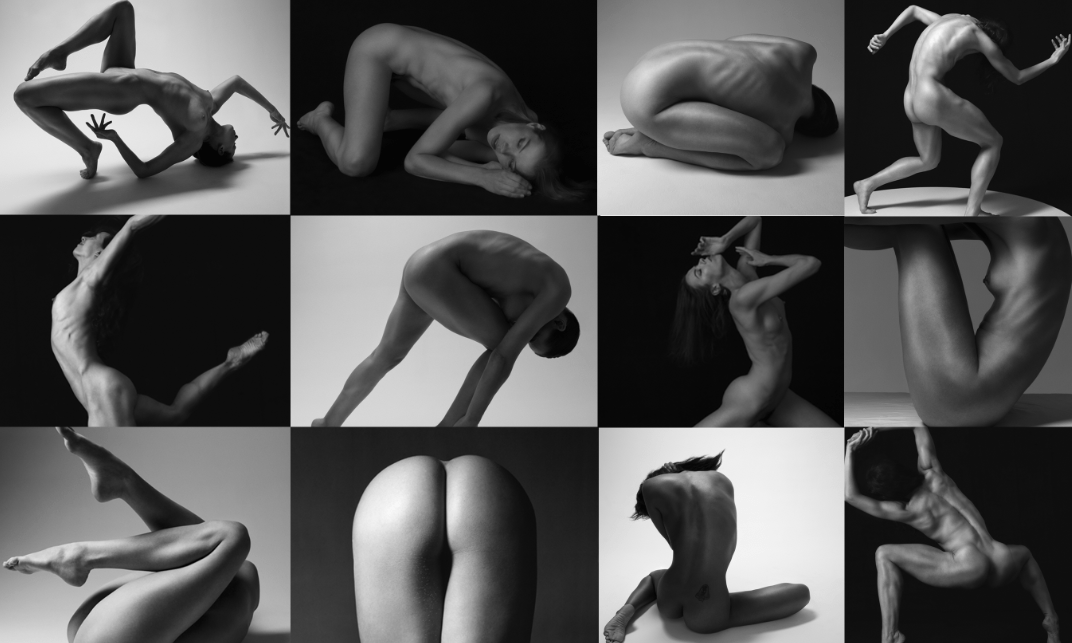
Anatomical Art¶
While the human figure has played a central role in art since the very beginning, an artist's rendering of the internal body is only as detailed as science's ability to understand and depict anatomy.Below are some of the artists sudies that are Highlighting the amazing complexity and the functions of human bodies.
Alain Pol
The Anatomy image Abdominal arteries false-colour arteriograph X-ray (angiograph) gives an absolute view of the blue sky with the pink clouds. The false-color arteriograph, also known as an angiograph, of the abdomen of a healthy adult human, created by injecting the arteries with a fluid that shows up as opaque when X-rayed.The image is the work of the prolific French photographer Alain Pol, who sets out to use arteriography to create anatomical images that are as beautiful
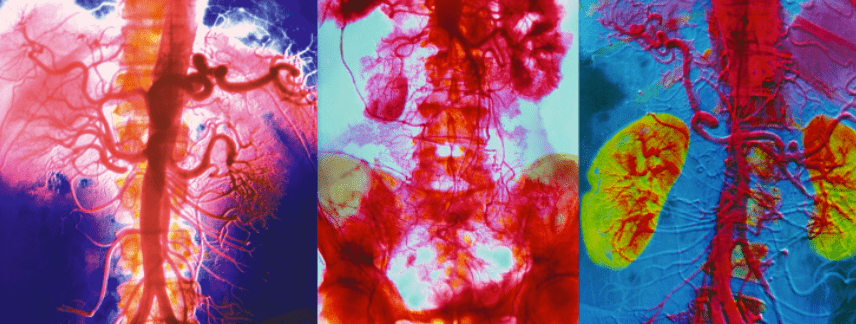
Cerebral Angiography
From the Alain pol references I found The cerebral angiography cerebral angiography, a beautiful visuals from th x-ray test of the brain. Cerebral angiography is a diagnostic test that uses an X-ray. It produces a cerebral angiogram, or an image that can help your doctor find blockages or other abnormalities in the blood vessels of your head and neck. Blockages or abnormalities can lead to a stroke or bleeding in the brain. For this test, a doctor injects a contrast medium into your blood. The contrast material helps the X-ray create a clear picture of your blood vessels so that your doctor can identify any blockages or abnormalities.

Walter Oltmann
The intricate artworks of Walter Oltmann that depict the human anatomy are so inspiring and artistic. Born in 1960 in Rustenburg, Gauteng, South Africa, Walter Oltmann’s main area of focus is sculpture, and more particularly in fabricating woven wire forms.
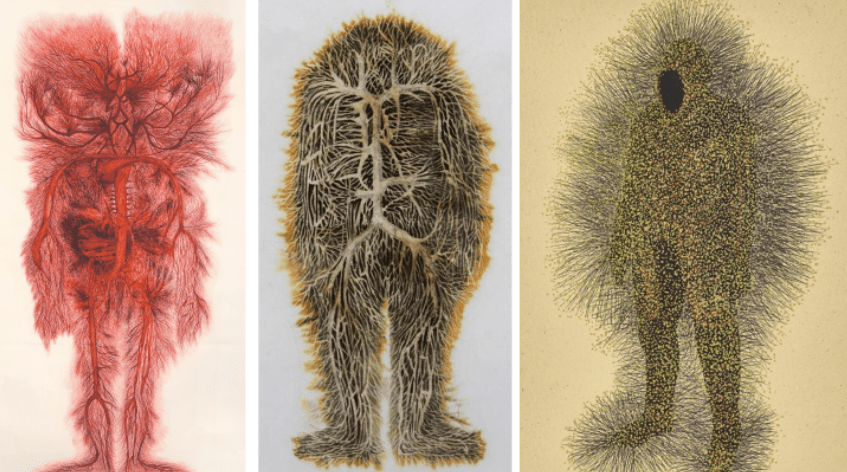
Rebecca Harris
"Edinburgh-based artist, researcher and collaborator, Rebecca harris usees textiles and technology, to unveil the human body and create evocative and tactile sculptures, installations and embroideries that stitch art and science together. Textiles is what she describes as her main arts practice medium.
The below first 2 artworks first 2 artworksis about the enormous microbial community of our bodies known as the microbiome, consisting of trillions of bacteria, viruses and other microbes.she hand and machine embroidered artwork which is bright and tactile that enables the viewer to engage with the positive aspects of our microbial community.
In the second last image Topographic titled ‘Untitled (black MRI)’ Rebecca was explored how she could represent a three-dimensional object in two-dimensions by maintaining the flat surface.The example shows the thin interior and the fat encasing, how when staring at this image our viewing of this body oscillates between fat and thin.
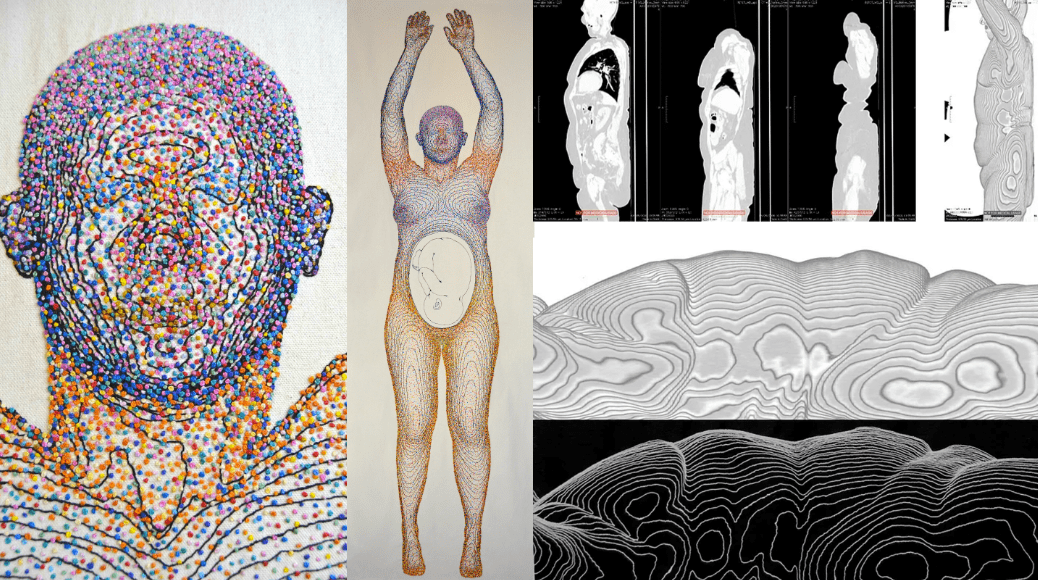
Claudius Galenus
The mid 15th century images shows both the outer as well as the inner structure of the body — is the striking "wound man" illustration, depicting a man who has been stabbed, bitten, and wounded by arrows, as well as bludgeoned in the arm and head.They appear to be some attempt to communicate all the different injuries to which the body can be subjected, in some cases offering up accompanying treatments.
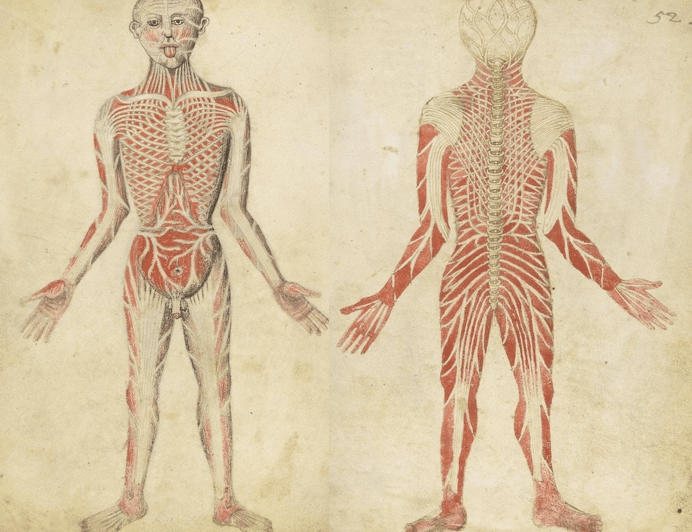
Lennart Nilsson
Lennart Nilsson was a Swedish photographer of human embryos and other medical subjects, his photographs are considered unphotographable, and more generally for his extreme macro photography. He was also considered to be among Sweden’s first modern photojournalists.
Lennart managed, for the first time in history, to photograph the human fetus from inside the uterus. This project called “A Child is Born” began in 1953 and took a total of 12 years to complete.

Travis Bedel
Travis Bedel, a Phoenix-based artist known for his intricate collages that blend human anatomy with nature. Bold botanical species, stunning flowers, tropical plants, colorful insects, and the makings of the human body harmoniously collide in his artworks
says- "My artwork is cut paper collage. My tools are glue and razor blades. I cut out from printed vintage etchings and illustrations to recombine them into an amalgamation of anatomical, botanical, and other biological parts.
In terms of connecting human anatomy to underwater organisms, I am very inspired by Travis Bedel's work.

Motion¶
Motion propels us in a given direction. Motion can be seen everywhere, when motion and the body become one there’s a chemistry that ignites a powerful captivating connection.

Artistic Movements¶

A study on Artists who use the physical body as a medium to create a greatest form on art.
Heather Hansen is a contemporary performance artist who creates organic illustrations through body motion gestures. With charcoal, Hansen creates the drawings. In a video entitled Emptying gestures, she displays her graceful and dramatic installation artworks. The movement of her body is directly reflected on the paper.
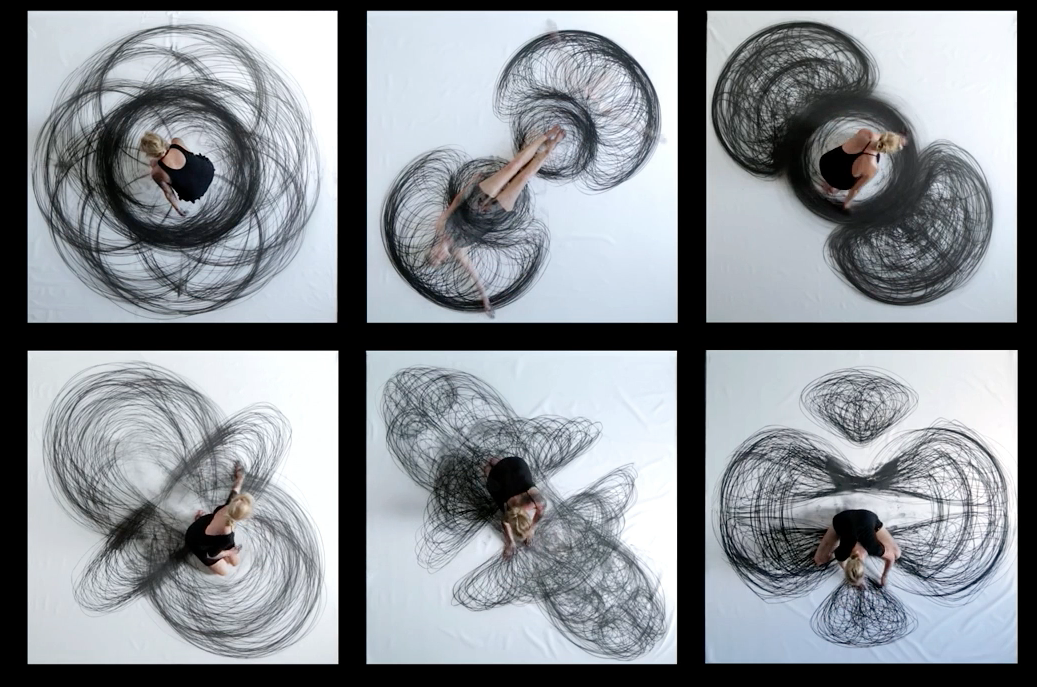
Caroline Denervaud is a contemporary and classic dance artist who focuses on each stroke and movement. As a tool, she uses charcoal, casein, paint and body movements to reinforce certain strokes and sustain the art by the colours.

Rebecca Horn is a multidisciplinary artist whose work encompasses sculpture, body art, paintings, films and poetry. In the first performances, the body-extensions, she explores the equilibrium between body and space then later works she replaces the human body with kinetic sculptures which take on their own life.

Her work is bound together by a consistency in logic; each new work appears to develop stringently from the preceding one. Elements may be readdressed, yet appear in totally different, divergent contexts.
The feathery white Mechanical Peacock Fan (1981) mimics the bird’s mating dance as it rises and falls majestically. A wheel of owl feathers, Zen der Eule (Zen of the Owl, 2010), collapses then regroups
Horn contracted a lung condition in 1968 that marked a significant turn to the bodily in her practice. Restricted from using certain sculptural materials as a result of this condition, softer elements found their way into her practice, resembling bandages or prostheses. In the performance piece White Body Fan (1972), for example, Horn reimagined early aviation fantasies by attaching white fabric, semi-circular wings to her body that flutter open with a raising of the arms.
Galia Eienschutz works on an investigation of transformation processes both in nature and in the body and consequently is directly linked to the creative process itself as a process of transformation.She constantly attempt to convert the processes of adaptation and displacement of the body in the environment.Her key tool is dance,movement and body itself. so she combine movement and drawing through a dance form somtime and somtimes with just the movement.

Peter Jansenuses shapes of the human body to create energetic spaces.In his recent sculptures he captures sequences of human movements in space and time, in a single frame as shown below.
His statues show the connections between the body and the limbs through the joints in the temporal continuity of a movement. It makes possible to understand physical movement but also the space/time relationship that defines it, such as accelerations or slowdowns.
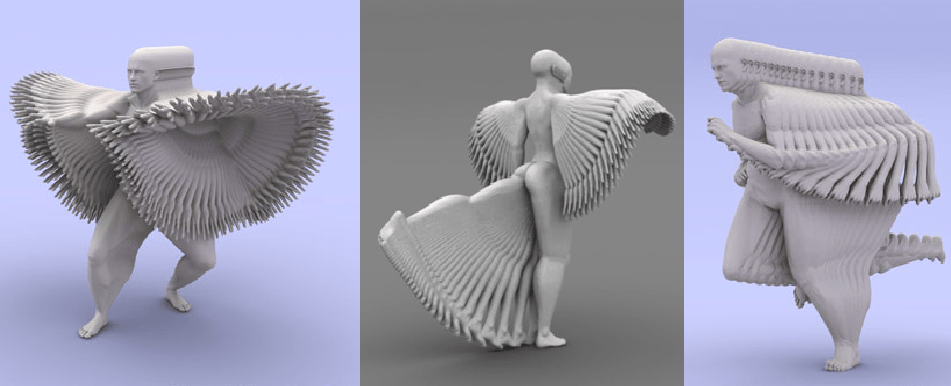 v=X5RUFXZZBH4&t=349s)
v=X5RUFXZZBH4&t=349s)
How Movements works in Human Anatomy¶
Anatomically, body movement refers to the articulations of the joints allowing a tremendous range of movement for the body. How each movement at a joint results from the contraction or relaxation of the muscles that are attached to the bones. The degree and type of movement that can be produced at a joint is determined by its structural type.

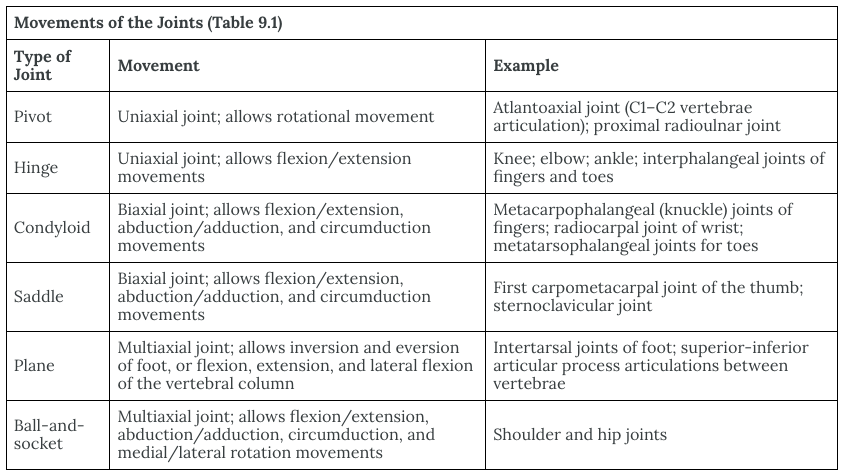
Synovial joints allow the body a tremendous range of movements. Each movement at a synovial joint results from the contraction or relaxation of the muscles that are attached to the bones on either side of the articulation.
While the ball-and-socket joint gives the greatest range of movement at an individual joint, in other regions of the body, several joints may work together to produce a particular movement. Overall, each type of synovial joint is necessary to provide the body with its great flexibility and mobility.
There are many types of movement that can occur at synovial joints (Table 9.1). Movement types are generally paired, with one directly opposing the other. Body movements are always described in relation to the anatomical position of the body.
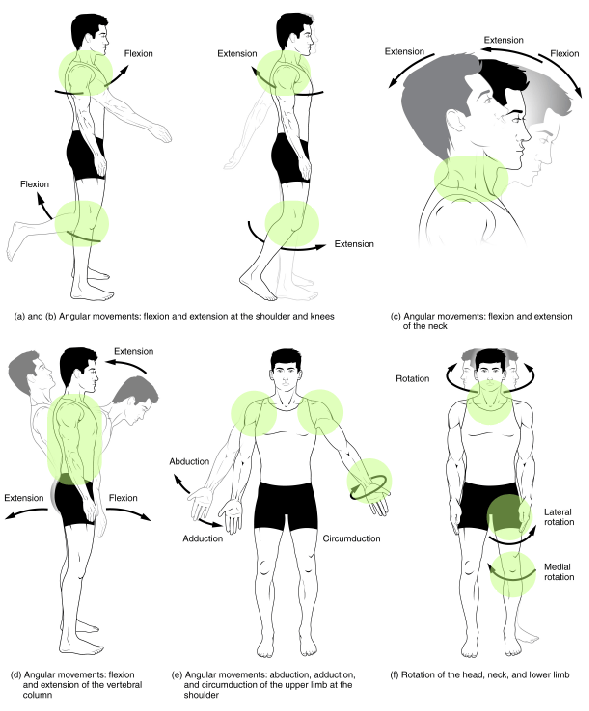
detailed explanations of the movements
Synovial joints give the body many ways in which to move.
(a)–(b) Flexion and extension motions take place at the shoulder, hip, elbow, knee, wrist, metacarpophalangeal, metatarsophalangeal, and interphalangeal joints.
(c)–(d) Anterior bending of the head or vertebral column is flexion, while any posterior-going movement is extension.
(e) Abduction and adduction are motions of the limbs, hand, fingers, or toes in the coronal (medial–lateral) plane of movement.
Moving the limb or hand laterally away from the body, or spreading the fingers or toes, is abduction.
Adduction brings the limb or hand toward or across the midline of the body, or brings the fingers or toes together.
Circumduction is the movement of the limb, hand, or fingers in a circular pattern, using the sequential combination of flexion, adduction, extension, and abduction motions.
Adduction/abduction and circumduction take place at the shoulder, hip, wrist, metacarpophalangeal, and metatarsophalangeal joints.
(f) Turning of the head side to side or twisting of the body is rotation. Medial and lateral rotation of the upper limb at the shoulder or lower limb at the hip involves turning the anterior surface of the limb toward the midline of the body (medial or internal rotation) or away from the midline (lateral or external rotation).
Understanding types of body Movements [Video Link](https://www.youtube.com/watch?
Topographic approach to the study of the human body¶
The topographic anatomical meridian is a line extending from the obelion and radiating outward, dividing the human body into planes. In these planes we can locate and study anatomical structures. The frontal (coronal) plane divides the body into anterior and posterior halves.

In medical terms topography is to study about the physical features of a surface of the human body, e.g., of the contours or slope of a body structure. Full article
A study about the Bodily topography of basic emotions
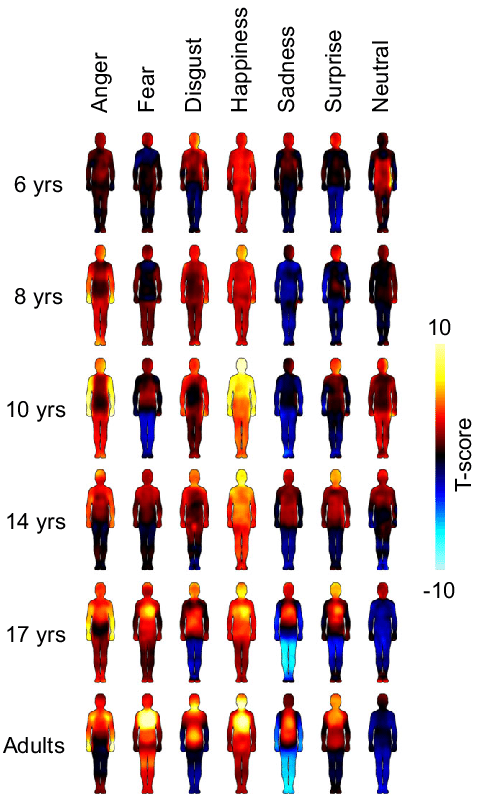
Bodily topography of basic emotions associated with the six basic emotions and neutral state. The body maps show regions whose activation increased (warm colours) or decreased (cool colours) when feeling each emotion.

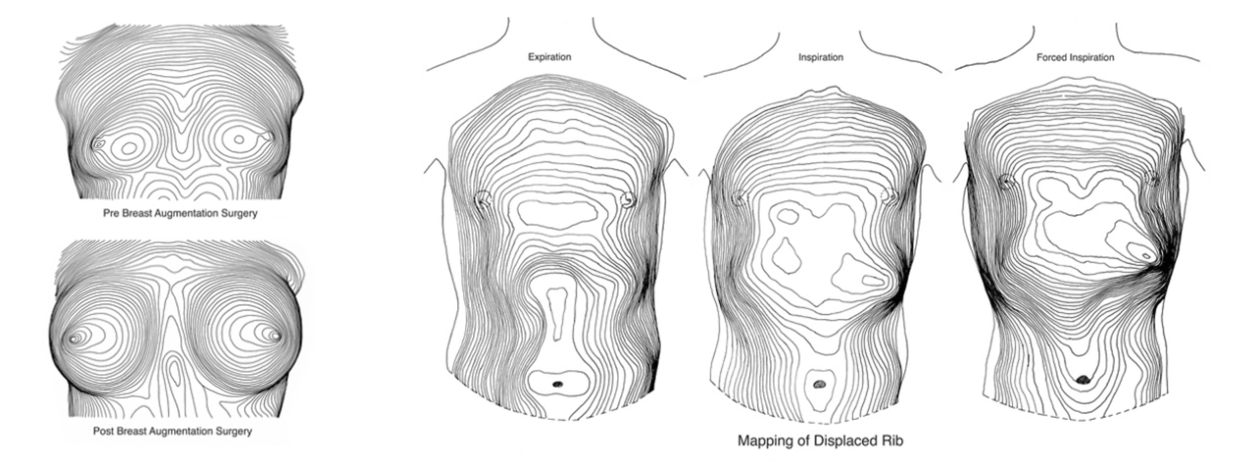


Robin Williamsdeveloped an innovative range of photographic methods for the measurement of three-dimensional shape, volume and surface area in vivo – contour maps of patients.
Skin Lines¶
Skin lines are classified as Externally Visible and Invisible lines.
The externally visible lines are Surface tension lines, Wrinkle lines, Joint lines, and Finger print lines
The Invisible lines are Cleavage / Langers line, Kraissl Lines, and Blaschkos line.
Cleavage / Langers Lines¶
Langer's lines or somtimes called cleavage lines are topological lines drawn on a map of the human body.
The tension lines of skin forms due to the pattern of arrangements of collagen fibers in the dermis.It is tend to spiral to longitudinal in the limbs and runs transversely in the neck and trunk. At the elbow, wrist, knee, and ankle are parallel to the transverse ceases that appears when the limbs are flexed.Langer's lines were defined in cadaver.
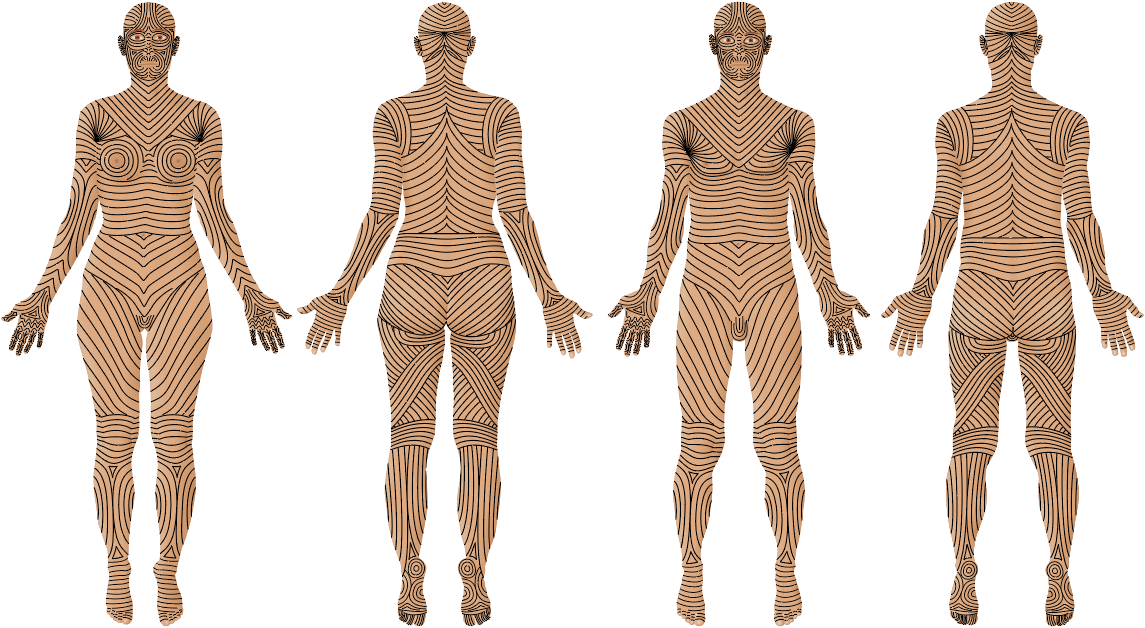
Kraissl Lines¶
The Kraissl's lines have been defined in living individuals. Kraissl lines are defined in term of collagen orientation, Kraissl's lines are the lines of maximum skin tension.

Blaschkos line¶
Blaschko's lines, also called the lines of Blaschko, are lines of normal cell development in the skin. These lines are only visible in those with a mosaic skin condition or in chimeras where different cell lines contain different genes.
The lines are believed to trace the migration of embryonic cells. They do not correspond to nervous, muscular, or lymphatic systems. The lines are not unique to humans and can be observed in other non-human animals with mosaicism.
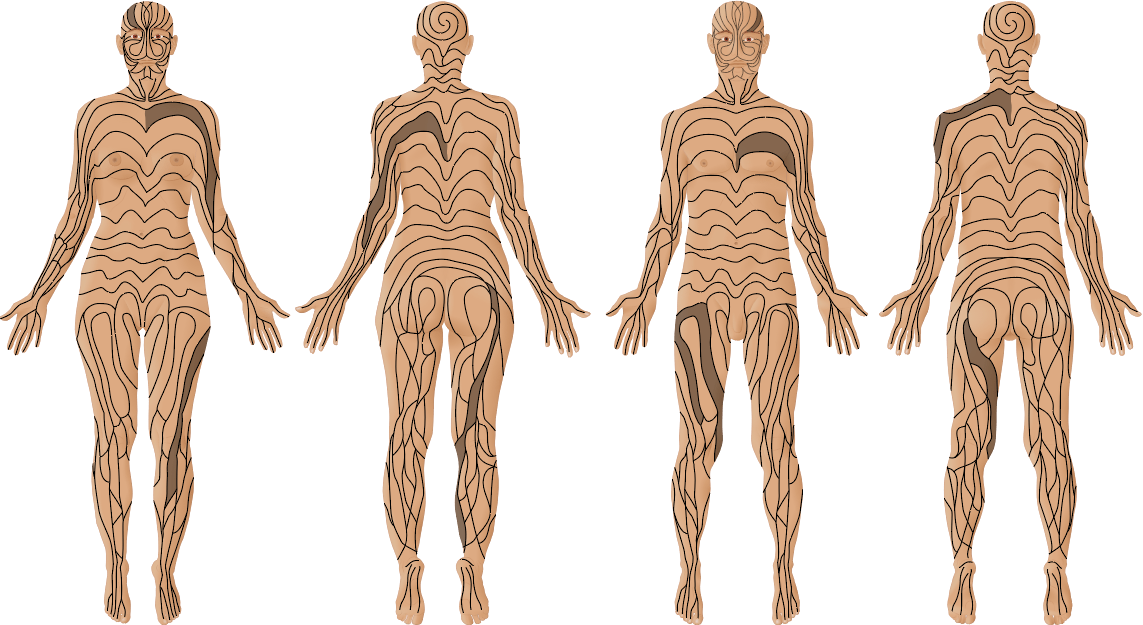
Human and ocean organisms¶
An Interesting study about how ocean organisms helped to study about Human body. Read full article

I found some interesting studies that connect the human body and ocean organisms. For instance, Sea slugs help to learn about the memories and horseshoe crabs teach how human eyes process the visual information. ain't that cool..lets deep dive and see how it was figured out by the researchers. in the early mid 20's when researchers were struggling to study about the neurons in the human body, as the technology was not yet miniaturised enough to study that are not even 10th the thickness of human hair. hmm... I can feel the pain!!! as a researcher at fabricademy. so when they began to look for the organisms with large nerve cells. Woods hole biologist L.W william discovered that squid had a giant nerve axon that helps them propel itself through water.It turns out that the nerve cells in the squid are 1000 times larger than the human's. The study helped the scientific community better understand how our human nervous system sends signals to our body.
Likewise, Sea urchins teach us about cell division. In 1982 a scientist called Tim Hunt observed fast-developing sea urchin embryos to identify the proteins that help fertilized eggs divide and grow. Those proteins are the very same catalysts that help humans develop in utero.
There are quite a few studies like..For icefish, anemia is a superpower, the scientists H. William Dietrich of Northeastern University and John Postlethwait of the University of Oregon studied the fish as a possible model for the human blood disorder known as anemia.
A sea slug becomes the key in a memory study, pheww! Do even sea slugs have a basic sense of memory?While humans have over 86 billion nerve cells in their brain, the California sea hare survives with only 20,000-many visible to the naked eye. Seeing through 445-million-year-old eyes- Researchers found that horseshoe crabs use three sets of eyes to sense basic differences in light.
As study on Artistic interpreation in design inspired by human body¶
Rottlace masks for Icelandic singer-songwriter Björk¶
A very relatelable and interesting project done by Neri oxman and her team.

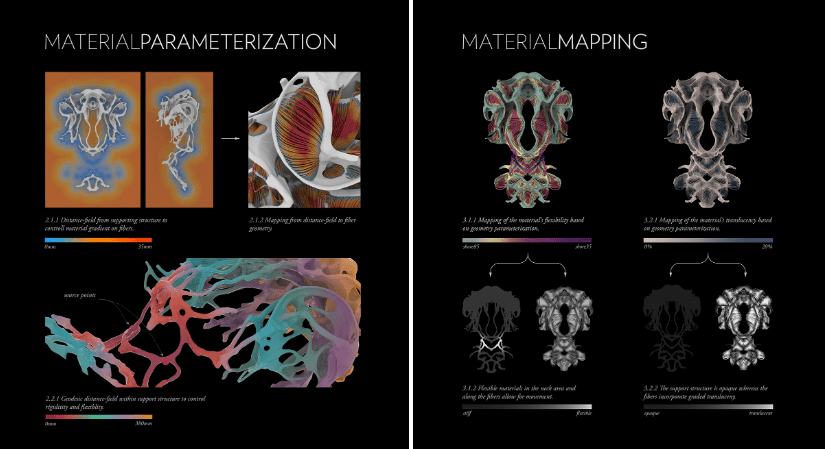
The Mediated Matter Group explored themes associated with self-healing and expressing ‘the face without a skin.The series originates with a mask that emulates Björk’s facial structure and concludes with a mask that reveals a new identity, independent of its origin. What originates as a form of portraiture culminates in reincarnation.
Using geometrical and material logics that resembles the human musculoskeletal system, espically the complex structure of muscles, connective tissues, tendons, and ligaments that modulate the human voice. The collagen fibers in the human face typologies like weaving the connections of muscle-to-bone, bone-to-bone, and muscle-to-muscle. the mask is designed without a parts. It also incorporate tunable physical properties recapitulating, augmenting, or controlling the facial form and movement behind them. Inspired by their biological counterpart, and conceived as ‘muscle textile,’ the masks are bundled, multi-material structures, providing formal and structural integrity, as well as movement, to the face and neck.The intricate fibrous tissue is made of soft and flexible materials designed to accommodate facial movement.
The mask is computationally generated and digitally fabricated in collaboration with stratsys using 3D printed multi materials. The computational framework enables micron scale control of 3D printable material placement over highly complex geometric domains.
Lazarus by Neri Oxman¶
A mask designed to contain the wearer’s last breath, new interpretation of the ancient death mask.
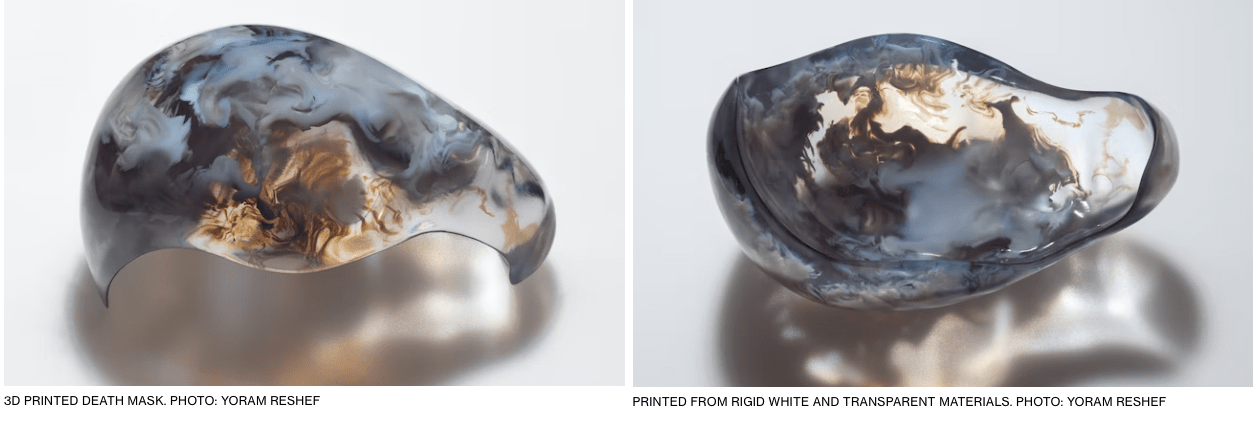
Traditionally the death mask is made of wax or plaster from the dead person to keep their mempry alive. unlike its traditional handmade, Oxman worked on the concept using entierly data driven design and digitally generated and additively manyfactured.Lazarus a 3d printed portraiture by combining the wearers facial features to enclosure for their last breath.It approaches the resolution of the physical phenomenon that it is designed to capture, thereby creating a unique artifact that is perfectly customized to fit the wearer and her last breath.

Chronomorphologic modeling¶

Chronomorphology is a recording of a moving object using photographs, instead using fulley scanned 3dimensional object and simulated in the digital environment to cteate a 3d printed object. This modeling interface uses a three phase workflow (3D scanning, 3D modeling, and 3D printing) to enable a designer to craft intricate digital geometries around pre-existing physical contexts. This virtual creature exists as a 3D printable module; it is constructed as a closed mesh, with a spring skeleton that prevents self-intersections. The composite, chronomorphologic model (of the virtual creature over time) retains these printable properties at each time-step. Therefore, no matter how intricate or complex, the digital geometry will always be exported as a valid, 3D printable mesh.
It begins with the scanning and importing the physical object to the virtual environment and the second face is creating the digital design where point cloud crteates on the scanned object when the scanning is done and designer animates using realtime gesture to create complex geometries and the printing phase to translate the digital file to physical object.
Conclusion¶
The structure and form of human anatomy are truly captivating, showcasing the beauty of muscles, veins, skin, and movement as a form of art. Inspired by the aesthetics of underwater organisms, I plan to design a fashion collection that incorporates body art and movement. Through the use of digital tools and sketches, I will apply patterns onto the human body and create garments using additive manufacturing technology. To transform the 3D printed textiles into wearable art, I will mold them onto the body, paying attention to the structured muscles to create a harmonious and captivating design.